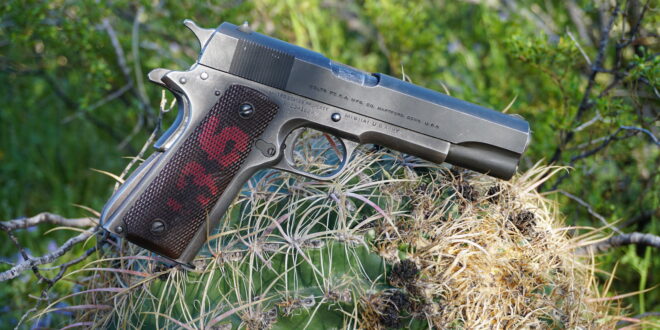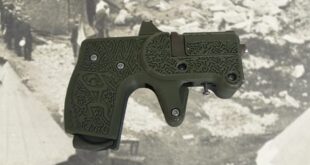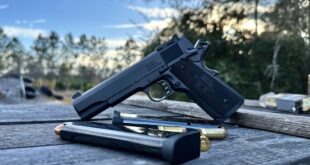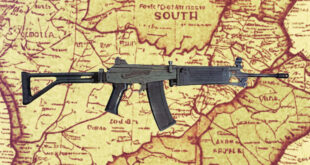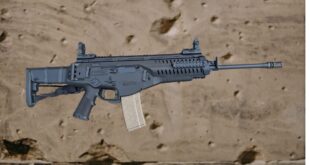by Scott Stipe
My first exposure to John Moses Browning’s iconic .45 caliber 1911 pistol was in the 1980’s, during my enlistment in the Arizona Army National Guard. Our unit had a weapons cage with a grumpy old sergeant who allowed us to touch and fire the M1911A1 45’s during our firearms qualifications.
READ MORE in Soldier of Fortune about John Brownings’ M1911
The 1911’s were only issued to the officers in the unit, but they did not actually carry the sidearm, so the 1911’s did not get much use or holster wear. They were clean and beautiful, and the expectation was they would be returned in the same condition or suffer the wrath of the old sergeant in the cage.
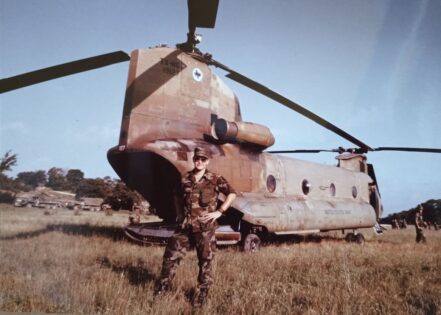
Scott Stipe at Fort Hood, Texas in the mid 1980’s.
They were a joy to shoot, and felt good in my hand. They were balanced, easy to shoot, and accurate at 10 yards, which is pretty much the longest distance you want to be engaging a target from anyway with a handgun. It goes back to the theory that your sidearm is used to get you back to your vehicle so you can grab your long gun and finish the fight.
Since that first exposure to the 1911, I had always wanted my own. However, I was a college student at the time and had no money to buy one, so that plan went on the back burner. Over the years after purchasing several revolvers and hunting rifles, I thought it was time to get one.
The cost of purchasing a genuine U.S. Army M1911A1 seemed out of reach. Currently, gun auctions typically sell World War I and World War II era 1911’s for between $2,000-$3,000, or higher. However, there was another option, the Civilian Marksmanship Program (CMP).
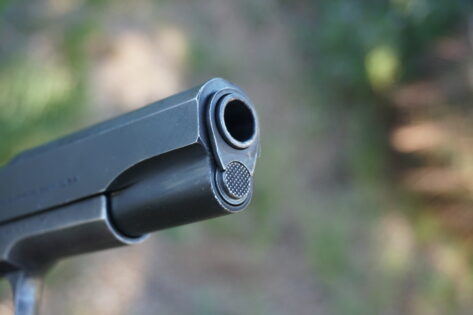
Created in 1903, the CMP sells surplus M1 Garand rifles and M1911A1 pistols. These firearms are inspected, graded, and test fired before being offered to the public in a lottery type of process. Some of the more rare and desirable examples are put on the CMP’s auction site for sale, as well.
In order to purchase a firearm, you must jump through some hoops, not a very difficult task for a law-abiding citizen who is actively involved in marksmanship training or competitions. You can only obtain one M1911A1 pistol through the CMP.
During October of 2022, I gathered all my paperwork and mailed the forms to the CMP to participate in their 1911 lottery. Yes, this is an old school snail mail, hard copy and wet ink process. On November 11, 2022, I received my Randomly Generated Number (RGN) via email. Over the course of the next five and a half months, I checked the CMP’s forum posts to see where my RGN was compared to others. The Round 1 participants waited two years to get their 1911’s, but the process has sped up, and the initial wave of people ordering 1911’s has slowed down.
Most of the CMP 1911’s available through the lottery are Colt, Remington Rand and Ithaca, or a blend of all three. Like Forrest said, “life is like a box of chocolates, you never know what you’re going to get!” All you get to do is pick which Grade (Service, Field, Rack or Range) of firearm when someone from the CMP calls you and says, “It’s your turn.” Also, not every Grade will be available when you get the call, so have a couple of options in mind.
Additionally, most of these old warhorses have been rebuilt a few times over their lifetime and may not have all their original factory issued parts. The military units and arsenals these firearms were sent to were more interested in making them solid functioning firearms for our troops. They were not interested in matching slides and frames or any other parts. Some have government contract replacement slides made of hardened steel; newer chrome lined barrels; different grips; and other parts. All these changes occurred for the betterment of the firearm for extreme use.
This concept is not appealing to everyone, but for those of us who want a piece of military history that has been used, it’s a great opportunity to own one.
On the morning of March 16, 2023, I got a call from Alabama! The CMP is ready to send me a 1911. The only Grade available was Rack, and I happily accepted it as I was hoping for a Rack or Field Grade pistol. By the following morning, I received a call from my Federal Firearms Licensed dealer, and he said my Colt had arrived! That was the first point when I discovered I now owned a Colt 45.
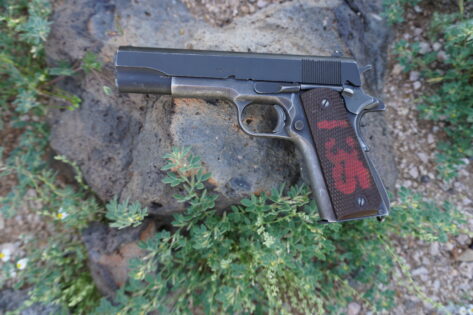
I rushed to the FFL, paid my transfer fee, and took possession of this wonderful piece of American military history.
The serial number on the frame indicated it was born in 1945. Information from the CMP forum indicated it was originally shipped to Springfield, Missouri between June and July of 1945. Based on the serial number, it was part of a batch of 1911’s sent to Headquarters Company of the Fleet Marine Force Pacific in August 1951.
I made a request for additional information through the Freedom of Information Act, and hope to get a response eventually. Some of the members on the CMP forum have received information as to where their 1911 spent some time, but not much past the 1980’s.
Some of the fun and interesting parts of owning these firearms is attempting to figure out the history and where these pistols have been and who touched them. Mine has the “Coltwood” plastic grips with a painted unit rack number. They are WWII era but not a matched set.
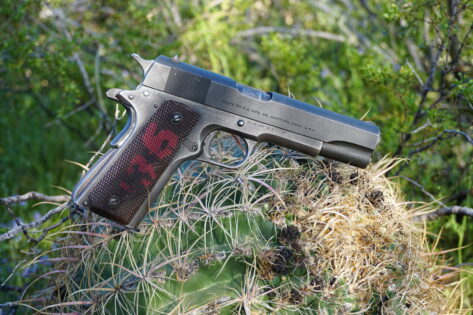
The slide is a Colt contract replacement slide that was probably made in the 1960’s. There were several manufacturers who were contracted to make the improved hardened steel slides, so it was nice to get an actual Colt slide that matched the Colt frame. The number “7790314” on the left side is not a serial number, it’s a contract number. The contract number on the chrome lined barrel is “7791193,” and the “85” designates it was made in 1985.
The markings tell a story. The “GHD” on the left side of the frame above the magazine release means the pistol was inspected under the authority of Brigadier General Guy H. Drewry at the Springfield Arsenal. The “P” under the magazine release is an inspector’s proof mark. The “VP” in the triangle and the other one on the top left side of the trigger guard are Colt inspector’s verified proof marks.
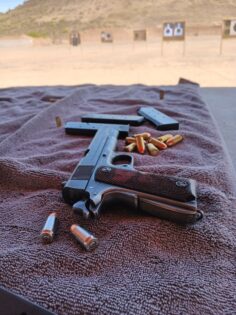
The Ordinance Department’s crossed cannons on the right side of the frame behind the grip is lightly stamped but visible, and was the final acceptance inspection marking for the firearm. The “73” on the right top side of the trigger guard is believed to be another inspector’s mark. The right side of the slide is marked “Colt’s PT. F. A. MFG. CO. HARTFORD, CONN. U. S. A.” The right side of the frame is marked “UNITED STATES PROPERTY’ “M1911A1 U.S. ARMY” as well as with the serial number.
The pistol came with the Pelican style case, one government contract magazine dated 1991, and a reprinted copy of the 1964 version of TM 9-1005-211-34, Maintenance manual for the M1911A1 Automatic .45 caliber pistol.
The pistol came clean and lightly oiled. I disassembled it and oiled it up some more, and it function checked well. I have taken it to the range several times, and ran around 200 rounds through it. I used six different magazines from a variety of three different manufacturers, including the one supplied by the CMP. The old Colt fired flawlessly.
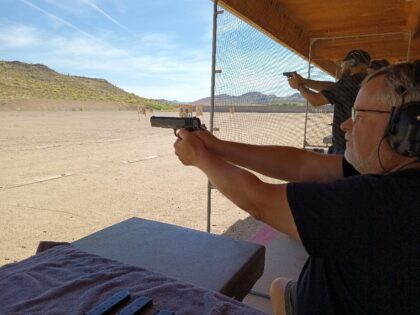
At 10 yards, the rounds had nice shot groups consistently high and left, and could have been an old blind shooter issue.
Overall, I’m very pleased with this 1945 piece of military history that I can actually shoot and enjoy.
Scott Stipe grew up on military bases in Europe and the United States, as his dad was in the U.S. Army. Scott served in the Arizona Army National Guard, and also spent 32 years working as a probation officer. He was an armorer for the agencies where he worked. He developed an appreciation for keeping the older military weapons like the 1911 in service condition.
 Soldier of Fortune Magazine The Journal of Professional Adventurers
Soldier of Fortune Magazine The Journal of Professional Adventurers


